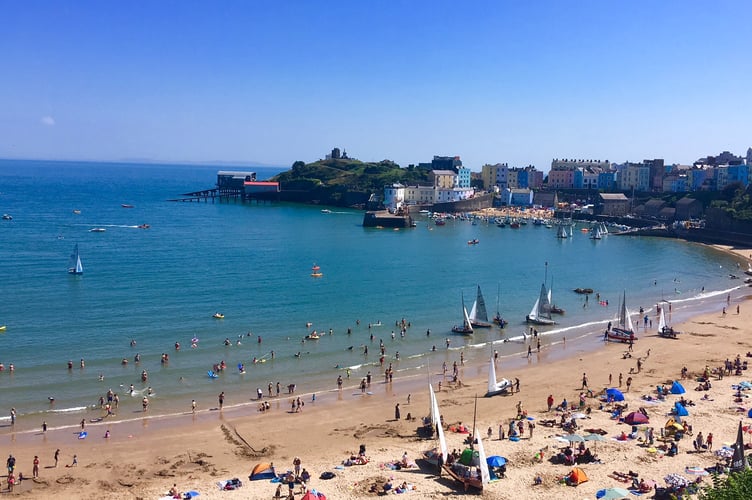Tenby Town Council are continuing to put pressure on Dŵr Cymru to invest in wastewater infrastructure to guarantee further reductions in Combined Sewers Overflows (CSO) and thoroughly investigate the cause of the intermittent poor water quality results on the seaside town’s North Beach.
Cllr Duncan Whitehurst recently presented a report to his fellow town councillors on behalf of the Tenby Clean Seas Working Group after meetings and discussions with Dŵr Cymru (Welsh Water).
He stated that a 2014 CEFAS (Centre for Environment, Fisheries and Aquaculture Science) report identified the River Ritec - which empties into the sea via the Ritec Culvert on South Beach - as a potential source of raised levels of bacteria in seawater.
He said it was disappointing that Dŵr Cymru and Natural Resources Wales (NRW) didn’t have appeared to have acted on the findings of the CEFAS report and investigated the potential of the River Ritec as a source of the intermittent poor water quality results on North Beach.
Furthermore, he stated that the potential of the Ritec as the source of bacteria on North Beach were dismissed due to the distance between the Ritec Culvert and the beach.

“There has been no investigation of the influence that marine currents could have in carrying outflow from the Ritec Culvert in the direction of Castle Beach and into North Bay,” stated Cllr Whitehurst in his findings.
“Dŵr Cymru and NRW maintain that CSO overflows may or may not contain sewage or other pollutants depending on the catchment area draining into the CSO.
“According to both organisations, media reports of sewage pouring into our seas are exaggerated when some/many CSOs typically handle unpolluted run-off during storm conditions - however, no test results were available to support this claim,” continued Cllr Whitehurst in his report to fellow town councillors.
Councillors said that they were surprised to hear that Natural Resources Wales do not test CSO discharges for pollutants because routine testing is not required under current discharge permit conditions, with this absence of scrutiny a matter for the Welsh Government to review.
Members of the Town Council expressed concern in response to Dŵr Cymru’s statement that the capacity of Tenby Waste Water Works can “accommodate a theoretical load from a population of 39,000 people” and that, by their calculations, peak population on a single day in the summer of 2021 was 38,496. Dyfed-Powys police estimate that the population in the Tenby area rises to over 60,000 in summer.
Such a dramatic rise in population could put the treatment works under significant pressure. It would explain why many CSO overspills occur during school holidays and weekends.
Dŵr Cymru replied that: “This is based on DCWW design standards for building a new activated sludge process and not to assess the capacity of an existing works.
“However, the reality is that it would be capable of treating flows and loads from a larger population than that and maintain compliance with the current discharge permit conditions.”
Cllr Whitehurst reported that this means that if Tenby WWTW has to treat effluent from a population of over 40,000, the process would involve stirring some more bacteria into the sewage sludge, which will digest more waste.
Once this option can process no more waste, the three pumping stations at Tenby, Saundersfoot and Manorbier go to overspill to ensure that the main works are not overwhelmed.
“The main results never go to overspill and consistently discharge bacteria-free UV-treated waste into the long-sea outfall,” he continued.
“However, as we understand it, the three pumping stations have the potential to discharge untreated waste into the environment and ‘maintain compliance with the current discharge permit conditions.’
“In 2018 Dŵr Cymru invested £400,000 in a new sewer in Castle Square to improve the performance of the Harbour/Castle Hill CSO. It hasn’t stopped the CSO from spilling completely but it was Tenby’s best-performing asset in 2022, spilling only once.
“The same can’t be said of the £1.5 million spent on a new sea outfall serving Saundersfoot Pumping Station, which spilt 70 times for a total of 1244.5 hours in 2022.
“Pumping stations normally overspill when the wastewater treatment works are over capacity, which suggests that improvements need to be made to Tenby WWTW to increase capacity beyond 40,000 in the summer.
“Dŵr Cymru could consider investigating Tenby WWTW’s performance to identify any required upgrades or rule it out as the cause of SPS 35 CSO’s overspilling.”
Cllr Whitehurst explained that data shows a trend towards a steady decline in CSO overflows.
“Most of these occur in the autumn and winter, following sustained periods of heavy rain. As one of the primary holiday destinations in Wales, the expectation is that we should have clean seas all year round, and we can’t afford to be complacent about the frequency of winter overspills,” he continued.
“The additional problem we have in Tenby is the intermittent alerts at peak holiday times and the intermittent detection of E.Coli and Escherichia Coli bacteria in water quality samples collected off Tenby North Beach, which resulted in the beach losing Blue Flag status in 2021,” he added, stating that the Tenby Town Council would continue to seek to encourage Dŵr Cymru to invest in wastewater infrastructure to guarantee further reductions in CSO overflows and thoroughly investigate the cause of the intermittent poor water quality results on Tenby North Beach.
He said that the Tenby Clean Seas Working Group having developed a good working partnership with the water company, would continue to look at the evidence available to make a case for future investment in Tenby’s sewer systems and wastewater treatment facilities.
Tenby Clean Seas Working Group will meet representatives from Dŵr Cymru, Natural Resources Wales and Pembrokeshire County Council in the Autumn following 2023’s testing programme results.
Cllr Laurence Blackhall congratulated Cllr. Whitehurst on his thorough report, stating this was the most information received for a very long time.
He said an interesting point about the North Beach is that readings are over 4 years, so there is a knock-on effect. The water quality is good but the statistical way of doing things can result in the loss of the Blue Flag.

He felt it was good that Dŵr Cymru were committed to having ongoing meetings with different agencies.
“While we may not be at the top of list, we should not underestimate the point of being a nuisance,” commented Cllr Blackhall.
Cllr. Emma Lewis wondered if the fact that over 2,000 Ironman swimmers use the North Beach could assist in adding pressure which could tip the balance.
Cllr Whitehurst said, at the end of the day, it all comes back to Welsh Government.
“Dŵr Cymru are doing their job within the regulations, the legislators who set those standards need to ensure they are fit for purpose,” he stated.



